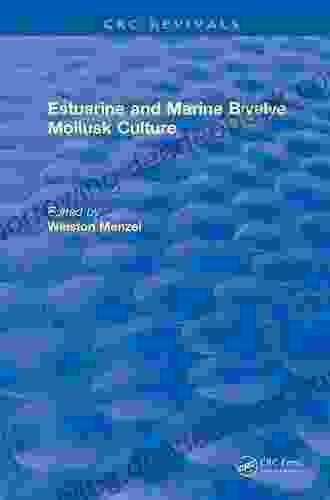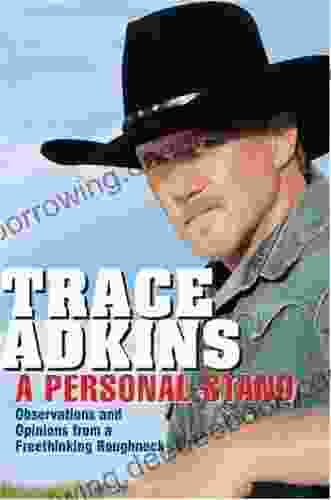Estuarine and Marine Bivalve Mollusk Culture: A Comprehensive Exploration

Bivalve mollusks, including oysters, clams, and mussels, are highly valued seafood species that play a significant role in marine ecosystems and human livelihoods. Estuarine and marine bivalve mollusk culture, also known as bivalve aquaculture or shellfish farming, is the controlled cultivation and harvesting of these bivalves in coastal waters. This practice has gained global prominence due to its potential to provide sustainable food sources, economic benefits, and environmental remediation.
Cultivation Techniques
Bivalve mollusk culture involves various cultivation techniques tailored to different species and environmental conditions.
4.3 out of 5
| Language | : | English |
| File size | : | 47470 KB |
| Text-to-Speech | : | Enabled |
| Screen Reader | : | Supported |
| Enhanced typesetting | : | Enabled |
| Print length | : | 371 pages |
Oyster Culture
Oysters are typically cultivated on oyster beds in intertidal or subtidal zones. Techniques include rack and bag, longline, and off-bottom culture. In rack and bag culture, oysters are placed in mesh bags and suspended from racks. Longline culture involves suspending oysters from ropes or wires. Off-bottom culture involves growing oysters on elevated platforms or cages.
Clam Culture
Clams are cultivated on sandy or muddy substrates. Techniques include intertidal culture, subtidal culture, and suspended culture. Intertidal culture involves growing clams on exposed tidal flats. Subtidal culture involves cultivating clams below the low-tide line. Suspended culture involves growing clams in suspended mesh bags or trays.
Mussel Culture
Mussels are often cultivated on ropes or lines suspended from rafts or longlines. They can also be grown on poles or stakes driven into the seabed. Techniques include single-line, double-line, and seed-on-rope culture. Single-line culture involves suspending mussel ropes from a single horizontal line. Double-line culture involves suspending ropes from two parallel horizontal lines. Seed-on-rope culture involves attaching mussel spat (juvenile mussels) directly to ropes.
Global Production
Estuarine and marine bivalve mollusk culture is a global industry with an annual production exceeding 20 million metric tons. China is the leading producer, accounting for over 80% of global production. Other major producers include South Korea, Japan, the United States, and Chile.
Oysters and clams dominate global bivalve production, with mussels accounting for a smaller share. China is the largest producer of oysters and clams, while Chile is the leading mussel producer.
Environmental Impact
Bivalve mollusk culture can have both positive and negative environmental impacts.
Positive Impacts
* Filtration and Water Quality Improvement: Bivalves filter water to feed, removing suspended particles and improving water clarity. This can enhance the health of marine ecosystems and support other marine life. * Habitat Creation: Bivalve reefs and beds provide habitat for other marine organisms, increasing biodiversity and supporting food webs. * Nutrient Cycling: Bivalves contribute to nutrient cycling by releasing nutrients into the environment through their waste products. This can benefit primary producers and other marine life.
Negative Impacts
* Carrying Capacity: Excessive bivalve culture can deplete food resources and exceed the carrying capacity of the environment, potentially harming other marine life. * Diseases: Bivalve culture can spread diseases among bivalve populations and potentially to wild populations. * Habitat Alteration: Bivalve culture can alter the physical structure of the environment, potentially impacting other marine species.
Ecological Benefits
Bivalve mollusks play an important role in marine ecosystems, providing various ecological benefits.
* Food Source: Bivalves are a food source for numerous marine predators, including fish, birds, and marine mammals. * Habitat: Bivalve reefs and beds provide habitat for a wide range of marine organisms, including fish, crustaceans, and worms. * Water Filtration: Bivalves filter water to feed, removing suspended particles and improving water quality. * Nutrient Cycling: Bivalves contribute to nutrient cycling by releasing nutrients into the environment through their waste products. This can benefit primary producers and other marine life.
Economic Benefits
Estuarine and marine bivalve mollusk culture is an important economic activity worldwide.
* Food Security: Bivalve culture provides a reliable and sustainable source of food for a growing global population. * Employment: The bivalve industry generates employment opportunities in various sectors, including cultivation, processing, and distribution. * Economic Development: Bivalve culture can contribute to economic development in coastal communities by creating jobs and generating revenue. * Tourism: Bivalve culture can attract tourists and support tourism-related businesses in coastal areas.
Sustainability Considerations
Ensuring the sustainability of estuarine and marine bivalve mollusk culture is crucial for preserving its ecological and economic benefits. Sustainable practices include:
* Environmental Monitoring: Regular monitoring of water quality, habitat conditions, and bivalve health is essential to ensure the sustainability of bivalve culture operations. * Disease Management: Effective disease management strategies are necessary to prevent disease outbreaks and minimize their impact on bivalve populations. * Responsible Siting: Bivalve culture operations should be located in areas with suitable environmental conditions and minimal conflicts with other marine activities. * Best Management Practices: Implementation of best management practices, such as proper waste disposal and responsible use of antibiotics, is crucial to minimize the environmental impact of bivalve culture.
Estuarine and marine bivalve mollusk culture is a complex and multifaceted industry with significant environmental, economic, and nutritional implications. By adopting sustainable practices, exploring innovative cultivation techniques, and addressing environmental challenges, we can harness the potential of bivalve culture to provide food security, economic benefits, and ecosystem services for generations to come. Collaboration between researchers, farmers, policymakers, and conservationists is essential to ensure the long-term sustainability of this vital industry.
4.3 out of 5
| Language | : | English |
| File size | : | 47470 KB |
| Text-to-Speech | : | Enabled |
| Screen Reader | : | Supported |
| Enhanced typesetting | : | Enabled |
| Print length | : | 371 pages |
Do you want to contribute by writing guest posts on this blog?
Please contact us and send us a resume of previous articles that you have written.
 Chapter
Chapter Text
Text Story
Story Library
Library E-book
E-book Magazine
Magazine Newspaper
Newspaper Paragraph
Paragraph Bookmark
Bookmark Shelf
Shelf Glossary
Glossary Preface
Preface Manuscript
Manuscript Tome
Tome Bestseller
Bestseller Classics
Classics Library card
Library card Narrative
Narrative Biography
Biography Autobiography
Autobiography Memoir
Memoir Encyclopedia
Encyclopedia Thesaurus
Thesaurus Narrator
Narrator Librarian
Librarian Catalog
Catalog Stacks
Stacks Periodicals
Periodicals Scholarly
Scholarly Lending
Lending Reserve
Reserve Academic
Academic Journals
Journals Reading Room
Reading Room Rare Books
Rare Books Special Collections
Special Collections Storytelling
Storytelling Reading List
Reading List Book Club
Book Club Theory
Theory Aharon Levran
Aharon Levran Nick Cutter
Nick Cutter Diane Trull
Diane Trull Bruno De Stefano
Bruno De Stefano John Dunlavey
John Dunlavey Christopher J Perkins
Christopher J Perkins John Rowan
John Rowan Carol Higgins Clark
Carol Higgins Clark Susan Levine
Susan Levine Alistair Mcdowall
Alistair Mcdowall Melanie Hernandez
Melanie Hernandez Sierra Simone
Sierra Simone Carter Houck
Carter Houck Alice Evleth
Alice Evleth Paul Gill
Paul Gill Peter Bone
Peter Bone Mitch Levin
Mitch Levin Kjell Brataas
Kjell Brataas Kelly Capriotti Burton
Kelly Capriotti Burton Al Braden
Al Braden
Light bulbAdvertise smarter! Our strategic ad space ensures maximum exposure. Reserve your spot today!
 Rob FosterFollow ·6.6k
Rob FosterFollow ·6.6k Guy PowellFollow ·10.6k
Guy PowellFollow ·10.6k Warren BellFollow ·2.3k
Warren BellFollow ·2.3k Travis FosterFollow ·18.7k
Travis FosterFollow ·18.7k Asher BellFollow ·11k
Asher BellFollow ·11k Eddie PowellFollow ·4.8k
Eddie PowellFollow ·4.8k Mason PowellFollow ·17.1k
Mason PowellFollow ·17.1k Mitch FosterFollow ·7.6k
Mitch FosterFollow ·7.6k

 Darius Cox
Darius CoxThe Gathering Pacific Storm: An Epic Struggle Between...
The Gathering...

 Hugo Cox
Hugo CoxHow CIA-Contra Gangs and NGOs Manufacture, Mislabel, and...
In the annals of covert operations, the CIA's...

 Finn Cox
Finn CoxDr. Brandt's Billionaires Club Series: The Ultimate...
A Journey into the Pinnacle of...

 Isaac Asimov
Isaac AsimovCurrent Affairs Daily Digest 20180730 30th July 2024
National ...

 Felix Carter
Felix CarterBroadway Celebrates The Big Apple Over 100 Years Of Show...
Broadway Celebrates the Big Apple: Over 100...

 Beau Carter
Beau CarterThe Big Book of Flute Solos: A Comprehensive Collection...
If you're a flute player,...
4.3 out of 5
| Language | : | English |
| File size | : | 47470 KB |
| Text-to-Speech | : | Enabled |
| Screen Reader | : | Supported |
| Enhanced typesetting | : | Enabled |
| Print length | : | 371 pages |












